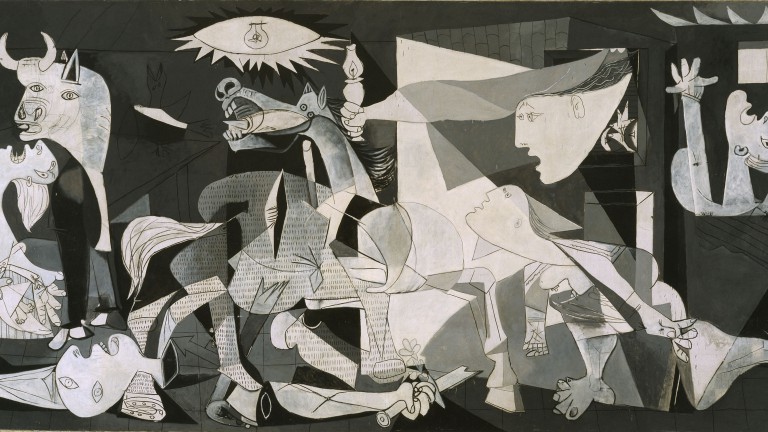Dr Fernando Gómez Herrero, Honorary Fellow in Birkbeck’s Department of Cultures and Languages, reports back from an international conference in Barcelona which focused mainly on the contemporary history of the Spanish Civil War and World War II.

Pablo Picasso’s ‘Guernica’ (1937). The artwork illustrates the violence and chaos of the Spanish Civil War and brought worldwide attention to the conflict.
Inside graffitied buildings at the University of Barcelona by the elegant Las Ramblas, I addressed the topic of intellectual life and the aftermaths of war in relation to three noted figures, mostly in the second half of the twentieth century. I brought “Dos Carlos,” so to speak, to the small-space of the Iberian peninsula, mostly during the Franco Regime but also after. Does any of this conservative and authoritarian thought, in complicity with early Nazism, remain alive today vis-à-vis the still prevailing orthodoxy of the “liberal West”? Symptoms of the loosening of the “liberal order” are easy to detect in different institutions, politics, university and mass media to name a few inside disparate national climates such as Brexit vis-à-vis the European Union, Trump America, etc. This international conference had three languages in unequal relationship (Catalan, Spanish and English) and the focus was mostly on the contemporary history coming out of the Spanish Civil War and World War II. Are we witnessing a turn to the Right, a revolt of the masses, even a Right-bound populism (what some authors call the “great Regression,” H Heiselberger for example)? Can we learn anything from the geopolitical situation of the following three figures of uneven visibility and uncertain impact?
These figures are: Carl Schmitt (1888-1985), Enrique Tierno Galván (1918-1986) and Camilo Barcia Trelles (1888-1977), not to be mistaken with his brother Augusto Barcia Trelles (1881-1961), also an interesting figure for another time and place. I addressed internationalism in relation to big-spaces and small-spaces, Grossraum and Reich, legal order and disorderly war, vis-à-vis the legacy of the Monroe Doctrine and the rise of the universalist-liberal ideology denounced as imperialist already by 1939 by Schmitt, sitting uncomfortably on the side of Nazi Germany losing WWII. This ineluctably dangerous thought emerges from the demise of imperial European hegemony, whilst marking differences from the Anglophone world and always keeping distance from the Left tradition emanating from Soviet Russia. Schmitt had plenty of (intellectual) life in him after such defeat finding refuge in the Iberian peninsula for four decades. This presentation developed the significance of such small-space for the historical geopolitics emerging from the middle of the twentieth century (we can think of the scale that goes from city of Barcelona, Catalonia, Spain, Europe, the West, etc.).
What are we to understand by the ominous sign of “war”? A permanent condition of being? Severe, harrowing test indeed big-time-big-space form of politics? Is there a way out of such politics? Law? Peace? What follows “total war”? Is international law the next chapter of significant difference? Or the first chapter that will be inevitably followed by disorder? What notions of “space” do we see emerging in between 1939 & 1945 and after? Schmitt’s spatialization of social energies: still convincing or useful methodology? What is missing? What is not to be touched with a ten-foot pole? What is the Spanish rendering of the alleged German scholar? What are the differences among these three European authors? Who are they turning to, conversing with? Their blind spots? Where is this Europe –and the liberal West with it– going in the 1950s between the two superpowers (U.S. and USSR)? Towards an inevitable debilitation? This presentation handled some of these burning issues. I played off the contrast with Anglophone environments.

L-R: Giovanni Cattini (Universitat de Barcelona), Fernando Gómez Herrero (Birkbeck and University of Birmingham, U.K.), Marcio Orozco (Universidad Panamericana, Mexico), Nick Sharman (University of Nottingham, U.K.).
Schmitt’s are strong words about the obfuscation and the falsification of the original Monroe Doctrine, also about the opportunistic use of messy geography emerging, the thinness of content and the doctrinal incongruence mobilized by the victors of WWI. There is insistence on the extension of the rule of the exception also in international law, that is nonetheless still monopolized by the Anglo Zone and paraded as triumphant narrative in the liberal West. Schmitt speaks of the universalist-imperialist principle of expansion in the Anglo Zone, the Americans picking up the legacy of the British Empire. Yet, international law will fly low in the United Nations in the following decades. There are also eerie sections about the elimination of the minority law in Schmitt, and we all know what that meant. His rejection of the ideals of assimilation, absorption and melting pots is blunt (it is important to remember contemporaneous Latin American thought experiments about “cosmic race” (Vasconcelos) and “transculturation” (F. Ortiz)). How did the Spaniards receive this profoundly uncomfortable thought in the 1950s and beyond?
It turned out that “Don Carlos” found refuge and community, circulation and outlet, even admiration in the Iberian peninsula, particularly Spain, in the final four decades of his long life. His daughter Anima Schmitt de Otero, who settled down in Franco Spain, acting as translator, representative and connector with several authorities and colleagues in legal and international studies. The Instituto de Estudios Políticos, Madrid gave him accolades. Manuel Fraga Iribarne (1922-2012) was among those “friends,” yet kept the figure of German intellectual at some distance. Among these “friends,” we have to include Tierno Galván whose article “Benito Cereno and the myth of Europe,” published in Spanish in 1952, recreates Schmittian’s Melville novel of a decrepit Europe giving way to some type of liberal American barbarism. What do we make of this article now 50 years after the publication of Sociología y Situación? There will be progressive distancing between Tierno Galván and Schmitt, as registered in Mehring’s extensive biography of the German intellectual. How are we to interpret today the gesture of the sociologist? Is the former Socialist Major of Madrid in the early moments of Spanish Democracy holding his own? The presentation answered some of these questions.
There is a second line of thought, which we may wish to call the Catholic international relations soon after WWII. Barcia Trelles, international-relations expert, managed to transition from Spanish-Republic and stay publicly active in the Franco Regime. He played a stellar role in the XIX World Congress “Pax Romana” (Spain, June-July 1946), event satirized by the English Catholic and conservative novelist Evelyn Waugh in his novel Scott King’s Modern Europe (1947), in honour of Francisco de Vitoria (1483-1546). What do we make of such initiatives in our own times? This paper contextualized and presented highlights of Barcia Trelles asking whether his vast scholarship remains of interest. Is this a third way? How are we to take the Catholic claims of a certain internationalism theoretically neither West nor East? Do we buy them? Schmitt praised Barcia Trelles’s formulations of land and sea in his magnus opus Nomos of the Earth. Is there evidence of a correspondence? American internationalist James Brown Scott (1866-1942) is in identical Vitoria circle in Spain bringing such legacy closer to the liberalism Schmitt denigrated. What do we make of it? Where to stand? Does law follow war, or is it the other way round? Isn’t it true that we live now in low-standing moments of international law in our convulsive times and foggy wars of uncertain end?
Schmitt has been a strong point of reference among social scientists and “humanists” from the Right and the Left in the two-to-three decades, at least in continental Europe, including to a lesser degree Britain, and U.S. foreign-affairs circles, expansively the Anglo-dominated North Atlantic. I am insisting on this visibility three decades after his demise. I took into consideration Writings on War (Polity, 2011) edited by Timothy Nunan, spanning 1939-1945. I took into account Tierno Galván’s article on Melville’s Benito Cereno and a selection of texts by Barcia Trelles in the 1930-50s located at the British Library. I was fortunate enough to find a rare book in the Ramblas during my visit: Cardinal Points of International Relations of Spain (1939), which will be incorporated in future works. I said a few words about the said Pax Romana conference. I quickly included references to Miguel Saralegui’s Carl Schmitt, pensador español (Trotta, 2016) and the monumental work of Reinahrd Mehring, Carl Schmitt: A Biography (Polity, 2014). The Spaniards also deserve a place at the discussion table. Reconstruction of their intellectual efforts also interrogates our moments of insights and persistent blindness.